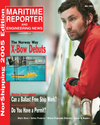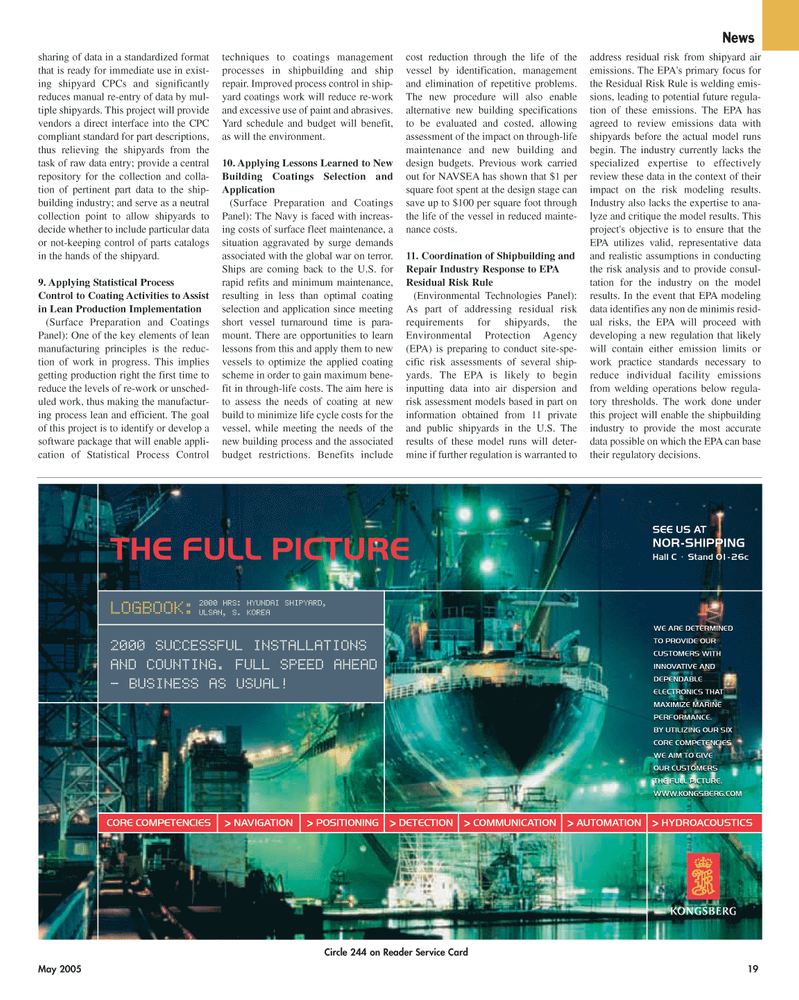
Page 19: of Maritime Reporter Magazine (May 2005)
Marine Enviroment Edition
Read this page in Pdf, Flash or Html5 edition of May 2005 Maritime Reporter Magazine
May 2005 19 sharing of data in a standardized format that is ready for immediate use in exist- ing shipyard CPCs and significantly reduces manual re-entry of data by mul- tiple shipyards. This project will provide vendors a direct interface into the CPC compliant standard for part descriptions, thus relieving the shipyards from the task of raw data entry; provide a central repository for the collection and colla- tion of pertinent part data to the ship- building industry; and serve as a neutral collection point to allow shipyards to decide whether to include particular data or not-keeping control of parts catalogs in the hands of the shipyard. 9. Applying Statistical Process
Control to Coating Activities to Assist in Lean Production Implementation (Surface Preparation and Coatings
Panel): One of the key elements of lean manufacturing principles is the reduc- tion of work in progress. This implies getting production right the first time to reduce the levels of re-work or unsched- uled work, thus making the manufactur- ing process lean and efficient. The goal of this project is to identify or develop a software package that will enable appli- cation of Statistical Process Control techniques to coatings management processes in shipbuilding and ship repair. Improved process control in ship- yard coatings work will reduce re-work and excessive use of paint and abrasives.
Yard schedule and budget will benefit, as will the environment. 10. Applying Lessons Learned to New
Building Coatings Selection and
Application (Surface Preparation and Coatings
Panel): The Navy is faced with increas- ing costs of surface fleet maintenance, a situation aggravated by surge demands associated with the global war on terror.
Ships are coming back to the U.S. for rapid refits and minimum maintenance, resulting in less than optimal coating selection and application since meeting short vessel turnaround time is para- mount. There are opportunities to learn lessons from this and apply them to new vessels to optimize the applied coating scheme in order to gain maximum bene- fit in through-life costs. The aim here is to assess the needs of coating at new build to minimize life cycle costs for the vessel, while meeting the needs of the new building process and the associated budget restrictions. Benefits include cost reduction through the life of the vessel by identification, management and elimination of repetitive problems.
The new procedure will also enable alternative new building specifications to be evaluated and costed, allowing assessment of the impact on through-life maintenance and new building and design budgets. Previous work carried out for NAVSEA has shown that $1 per square foot spent at the design stage can save up to $100 per square foot through the life of the vessel in reduced mainte- nance costs. 11. Coordination of Shipbuilding and
Repair Industry Response to EPA
Residual Risk Rule (Environmental Technologies Panel):
As part of addressing residual risk requirements for shipyards, the
Environmental Protection Agency (EPA) is preparing to conduct site-spe- cific risk assessments of several ship- yards. The EPA is likely to begin inputting data into air dispersion and risk assessment models based in part on information obtained from 11 private and public shipyards in the U.S. The results of these model runs will deter- mine if further regulation is warranted to address residual risk from shipyard air emissions. The EPA's primary focus for the Residual Risk Rule is welding emis- sions, leading to potential future regula- tion of these emissions. The EPA has agreed to review emissions data with shipyards before the actual model runs begin. The industry currently lacks the specialized expertise to effectively review these data in the context of their impact on the risk modeling results.
Industry also lacks the expertise to ana- lyze and critique the model results. This project's objective is to ensure that the
EPA utilizes valid, representative data and realistic assumptions in conducting the risk analysis and to provide consul- tation for the industry on the model results. In the event that EPA modeling data identifies any non de minimis resid- ual risks, the EPA will proceed with developing a new regulation that likely will contain either emission limits or work practice standards necessary to reduce individual facility emissions from welding operations below regula- tory thresholds. The work done under this project will enable the shipbuilding industry to provide the most accurate data possible on which the EPA can base their regulatory decisions.
News
CORE COMPETENCIES >
NAVIGATION >
POSITIONING >
DETECTION >
COMMUNICATION >
AUTOMATION >
HYDROACOUSTICS
THE FULL PICTURE
LOGBOOK: 2000 SUCCESSFUL INSTALLATIONS
AND COUNTING. FULL SPEED AHEAD - BUSINESS AS USUAL! 2000 HRS: HYUNDAI SHIPYARD,
ULSAN, S. KOREA
WE ARE DETERMINED
TO PROVIDE OUR
CUSTOMERS WITH
INNOVATIVE AND
DEPENDABLE
ELECTRONICS THAT
MAXIMIZE MARINE
PERFORMANCE.
BY UTILIZING OUR SIX
CORE COMPETENCIES
WE AIM TO GIVE
OUR CUSTOMERS
THE FULL PICTURE.
WWW.KONGSBERG.COM
SEE US AT
NOR-SHIPPING
Hall C · Stand 01- 26c
Circle 244 on Reader Service Card
MR MAY 2005 #3 (17-24).qxd 5/2/2005 6:39 PM Page 3

 18
18

 20
20
